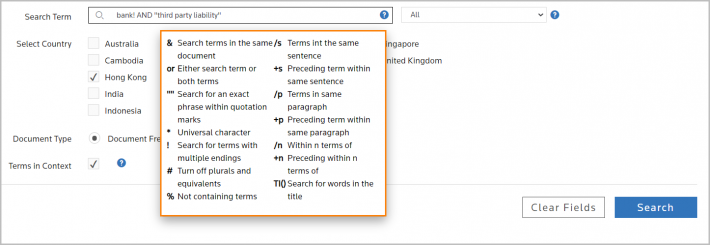Westlaw Asia (new) Guide - Boolean Terms and Connectors
Last Published: September 30, 2020

Boolean operators such as AND, OR, and BUT NOT allow you to refine and expand your search.
- AND finds results that have both words on either side of the ‘and’ operator, e.g., director AND insolvency
- OR finds results that have either word on each side of the ‘or’ operator, e.g., car OR truck
- BUT NOT finds the first word but not the second, e.g., child BUT NOT children
Terms include:
- Phrase searching, which uses “quotation marks” to find words exactly as written
- An exclamation mark to find the root of a word, e.g., claim! will show results with claim, claims, claimed, claimant, claiming, etc.
- An asterisk can be used to replace a single character, e.g., wom*n will show results with both ‘woman’ and ‘women’
Connectors include:
- /p and +p allows words or phrases to be found in the same paragraph of a document, e.g., fiduciary duty /p “winding up”
- /p means the words/phrases can be found in any order, e.g., ‘winding up’ can be before ‘fiduciary duty’ in the paragraph
- +p means the words must be found in the order as written, e.g., ‘fiduciary duty’ must appear before ‘winding up’ in the paragraph
- /s and +s allows words or phrases to be found within the same sentence of a document, e.g., negligence /s statutory duties
- /s means the words/phrases can be found in any order, e.g., ‘statutory duties’ can be found before ‘negligence’ in the sentence
- +s means the words must be found in the order as written, e.g., ‘negligence’ must appear before ‘statutory duties’ in the sentence.
- /n and +n allows words or phrases to be found within a number length of each other in a document, e.g., evidence /15 bias
- /n [number] means the words can be found in any order, e.g., 'bias' can be within 15 words before or after 'evidence'
- +n [number] means the words must be found in the order as written, e.g., 'evidence' must be found within 15 words before 'bias'
Attachments
Westlaw Asia - Terms and Connectors PDF (126.27kb)
